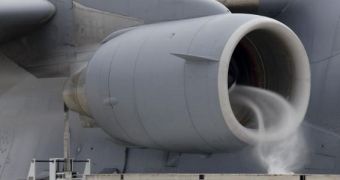The image above was taken during a series of tests conducted recently at the NASA Dryden Flight Research Center, at the Edwards Air Force Base (EAFB), in California. Engineers intentionally allowed a jet engine to suck in water from a special platform, in order to test new flight safety technologies.
The goal of the NASA Aviation Safety Program is to develop new sensors that can contribute to improving flight safety. One way of doing this is to keep a close eye on engine vibrations, speed, temperature and emissions. Changes in these factors can indicate potential problems.
What engineers are trying to do is develop technologies that would enable them to discover issues with aircraft engines before they occur, when they can still be mitigated by airport crews on the ground. This will reduce the occurence of mid-flight incidents.
The aircraft imaged here is a US Air Force C-17 transport aircraft. Its engine is seen sucking in a large volume of water, located on a special, erected platform. The assessment was part of the VIPR project engine health monitoring tests researchers at Dryden are currently conducting.

 14 DAY TRIAL //
14 DAY TRIAL //